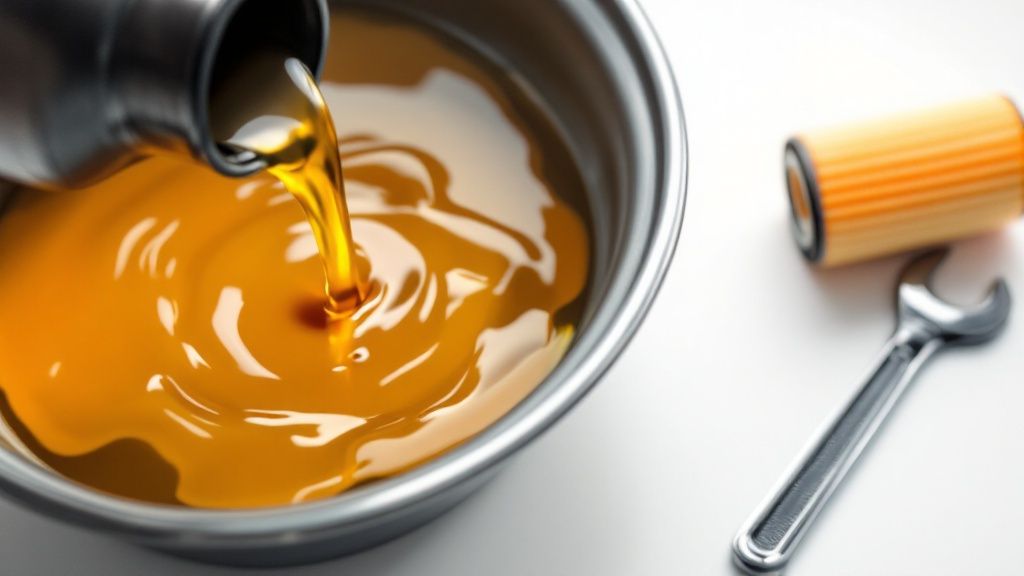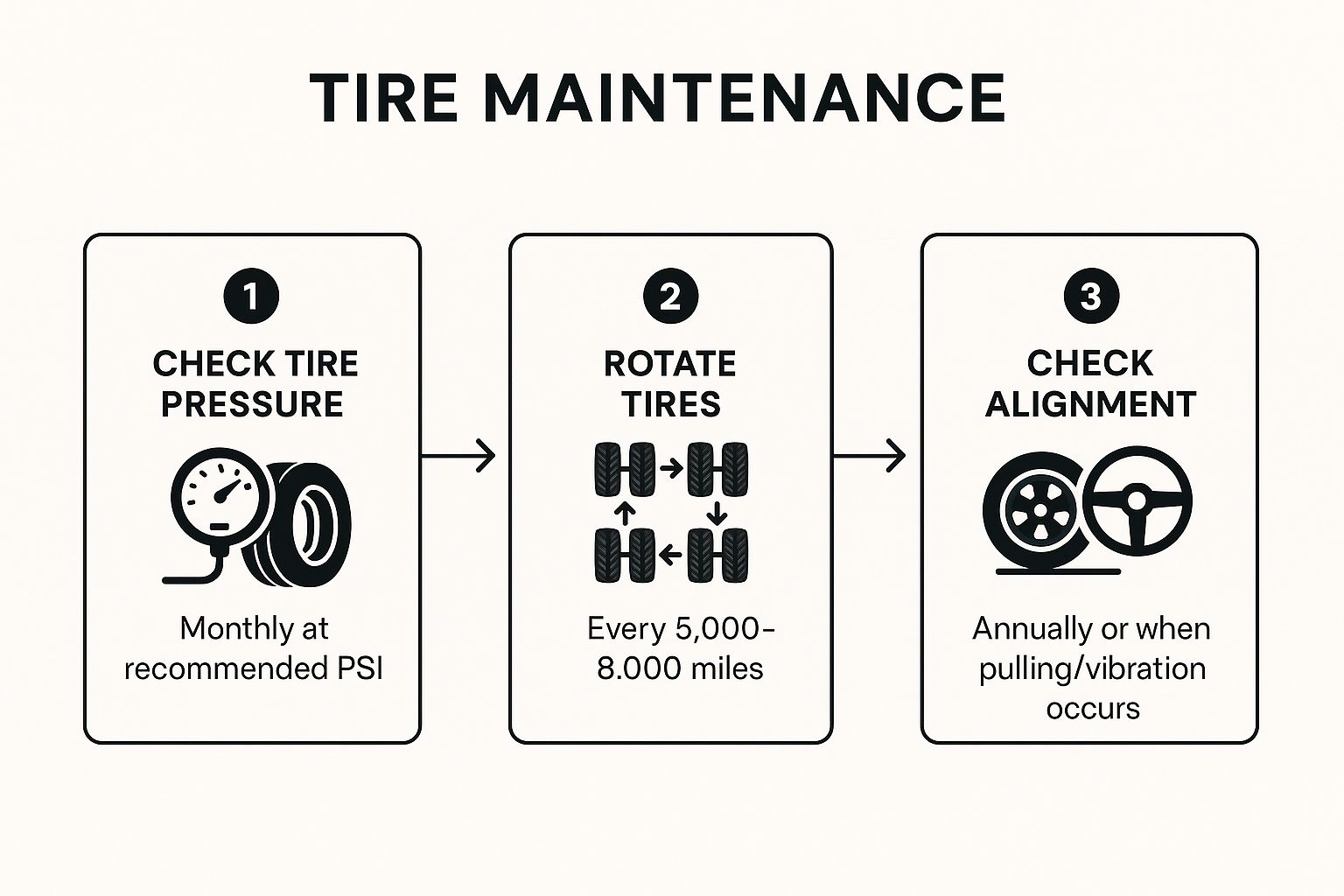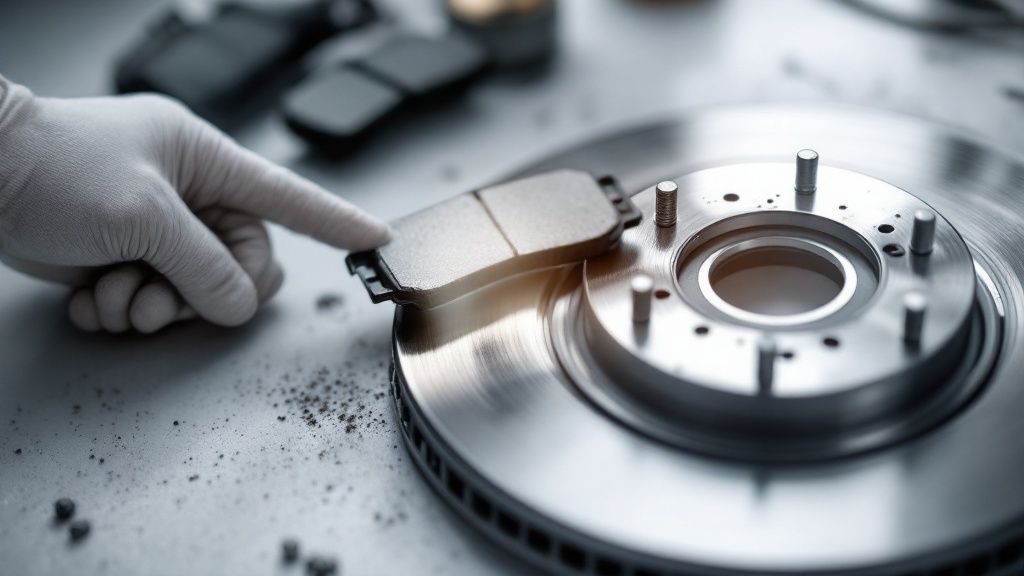This car maintenance checklist covers eight essential areas to keep your vehicle running smoothly and reliably. Following these simple checks can prevent costly repairs, extend your car’s life, and ensure your safety on the road. From regular oil changes and tire maintenance to brake inspections and fluid checks, this list provides a practical guide for all Dallas car owners and fleet managers. Whether you’re preparing for a Texas state inspection, need a quick diagnostic check, or are looking for transparent pricing on routine maintenance, this car maintenance checklist will help you stay on top of your car’s health.
Regular oil changes are a cornerstone of any effective car maintenance checklist. Engine oil is the lifeblood of your vehicle, lubricating critical engine components to minimize friction and prevent heat damage. Over time, this oil degrades, accumulating contaminants and losing its lubricating properties. Regular oil changes are essential to flush out these impurities and replenish the engine with fresh oil, ensuring optimal engine performance, efficiency, and longevity. This simple maintenance task can significantly extend the life of your engine and prevent costly repairs down the road.

A typical oil change involves draining the old, contaminated oil and replacing the oil filter. The frequency of oil changes depends on several factors, including the vehicle make and model, the type of oil used, and driving conditions. Generally, oil changes are recommended every 3,000 to 10,000 miles. Different oil types offer varying levels of protection and longevity. Conventional oil is the most basic option, while synthetic blends and full synthetic oils offer enhanced performance and longer change intervals.
Features of a Regular Oil Change:
Pros:
Cons:
Examples:
Tips for Car Owners (Dallas and beyond):
Whether you’re a Dallas resident looking for reliable car maintenance or a fleet manager in the City of Dallas seeking a comprehensive maintenance program, regular oil changes are a fundamental step in protecting your investment and ensuring optimal vehicle performance. This crucial item deserves its place at the top of any car maintenance checklist. While services like Jiffy Lube, Valvoline, Mobil 1, and Pennzoil have popularized quick oil changes, remember to choose a reputable service provider that prioritizes proper procedures and environmental responsibility.
Tire maintenance is a critical component of any car maintenance checklist, impacting everything from safety and fuel efficiency to the overall lifespan of your tires. Comprehensive tire care encompasses regular pressure checks, rotations, balancing, and alignment. Properly maintaining your tires ensures optimal vehicle handling, braking performance, and significantly reduces the risk of blowouts. Neglecting tire maintenance can lead to premature wear, decreased fuel economy, and compromised safety on the road.

This infographic visualizes the key data points and the process flow for effective tire maintenance.
The infographic illustrates the cyclical process of tire maintenance, starting with regular pressure checks. Following this, the diagram emphasizes the importance of tire rotation, typically every 5,000-8,000 miles. Next in the flow is wheel balancing, a crucial step for minimizing vibrations. Finally, the infographic highlights the importance of wheel alignment, which ensures that the tires are angled correctly for optimal performance and even wear. The sequence underscores the interconnectedness of each step in maximizing tire life and vehicle safety. By following this process, drivers can proactively address potential issues and prevent more costly repairs down the road.
Proper tire maintenance extends tire life by up to 50% and improves fuel efficiency by 3-4%. It also enhances vehicle handling and safety by ensuring optimal contact with the road surface, which is especially important for braking and cornering.
Features of a Comprehensive Tire Maintenance Program:
Pros:
Cons:
Examples of Successful Implementation:
Actionable Tips for Car Owners in Dallas and Beyond:
This video provides a visual demonstration of proper tire maintenance techniques.
Tire maintenance deserves a prominent place on any car maintenance checklist due to its significant impact on safety, performance, and cost savings. By following these guidelines, Dallas residents and drivers everywhere can ensure optimal tire performance and contribute to a safer driving experience. This is especially important for those seeking routine oil changes and preventative maintenance, fleet managers looking for reliable programs, and anyone needing state inspections or repairs. Proper tire care is not just good practice—it’s an investment in your safety and the longevity of your vehicle.
A critical component of any car maintenance checklist is regular brake system inspection. This involves checking the entire system, including brake pads, rotors, calipers, and brake fluid, to ensure they are functioning correctly. Proper brake maintenance is paramount for safety, preventing accidents, and avoiding costly repairs down the line. A well-maintained brake system ensures optimal stopping distance and reduces the risk of complete brake failure, keeping you and others safe on the road. This is especially important for Dallas residents navigating the city’s busy streets.

Brake system inspections should be part of any comprehensive car maintenance checklist, whether you’re a Dallas resident or a commercial fleet manager. A typical inspection schedule includes checking brake pads every 10,000-20,000 miles, flushing the brake fluid every 2-3 years (manufacturers like Honda recommend every 3 years regardless of mileage), inspecting rotors with every pad replacement, and performing a full system inspection annually. This proactive approach helps prevent costly cascade failures where a small problem, like worn brake pads, leads to damage of more expensive components like rotors.
Pros:
Cons:
Examples of Successful Implementation:
Actionable Tips for Car Owners in Dallas and Beyond:
Including a brake system inspection in your car maintenance checklist is essential for ensuring vehicle safety and preventing costly repairs. Whether you are a Dallas resident concerned about navigating city traffic, a commercial fleet manager focused on vehicle uptime, or simply a budget-conscious car owner, prioritizing brake maintenance is a vital investment.
A critical part of any car maintenance checklist is battery maintenance and testing. This involves regularly inspecting, cleaning, and testing your vehicle’s battery and charging system. Why is this so important? Because a healthy battery ensures reliable electrical system operation, prevents unexpected starting failures, and can save you the headache of a roadside breakdown, especially in extreme temperatures common in places like Dallas. Regular battery maintenance contributes significantly to a well-rounded preventative maintenance program for both individual car owners and commercial fleet managers in the City of Dallas.
How it Works:
Your car battery provides the initial electrical surge needed to start your engine. The charging system then takes over, replenishing the battery’s charge and powering the vehicle’s electrical components. Neglecting battery maintenance can lead to corrosion, reduced capacity, and ultimately, failure. This can leave you stranded, especially during extreme temperature swings which put additional stress on the battery.
Features of Battery Maintenance:
Pros:
Cons:
Examples:
Actionable Tips:
Why This Item Deserves its Place in the Car Maintenance Checklist:
Battery failure is a common cause of vehicle breakdowns. By including battery maintenance and testing in your car maintenance checklist, you can significantly reduce the risk of unexpected issues, prolong the life of your battery, and ensure reliable starting in all weather conditions. This is especially important for Dallas residents and businesses operating fleets in the city, given the challenging climate. This proactive approach aligns with the needs of budget-conscious consumers by preventing costly repairs down the road. It also ensures compliance for state inspections and contributes to the reliable operation of commercial fleets.
Keeping up with your car maintenance checklist is crucial, and a vital part of that is regularly checking and maintaining your vehicle’s fluid levels and condition. This goes beyond just your engine oil and includes other essential fluids like transmission fluid, coolant, power steering fluid, brake fluid, and even windshield washer fluid. Each of these fluids plays a critical role in the performance and longevity of different vehicle systems, and neglecting them can lead to costly repairs down the line. This is why it’s a key element in any comprehensive car maintenance checklist.
What it Involves and Why it Matters
This part of your car maintenance checklist involves visually inspecting and/or physically checking the levels of various fluids in your vehicle. It also means paying attention to the fluid’s condition — its color, smell, and consistency. For example, dark, burnt-smelling transmission fluid could signal a serious problem. Regularly checking these fluids helps you:
Specific Fluid Maintenance Requirements:
While checking fluid levels is relatively straightforward, each fluid has its own maintenance schedule and requirements:
Pros and Cons:
Pros: Prevents major repairs, identifies leaks, maintains optimal performance, simple visual checks can catch problems early.
Cons: Different fluids have different maintenance schedules, some fluids require special disposal procedures, some modern transmissions have sealed systems and may require dealer service.
Actionable Tips for Your Car Maintenance Checklist:
Examples:
Popular Brands: Prestone (coolant), Valvoline (transmission fluid), Lucas Oil (additives), ATE (brake fluid).
By including this crucial step in your car maintenance checklist, you can help ensure the smooth and reliable operation of your vehicle for years to come. Whether you’re a Dallas resident looking for reliable car maintenance tips or a fleet manager in the city of Dallas trying to optimize your fleet maintenance program, understanding and adhering to proper fluid maintenance schedules is vital. This proactive approach will ultimately save you time and money in the long run.
Air filter replacement is a crucial part of any car maintenance checklist, impacting both engine performance and the health of your passengers. This simple yet often overlooked task involves regularly inspecting and replacing both the engine air filter and the cabin air filter. Clean air filters are essential for optimal engine function, fuel efficiency, and clean air inside your vehicle.
How it Works: Your engine needs a constant supply of air to properly mix with fuel for combustion. The engine air filter prevents dust, dirt, insects, and other debris from entering the engine and causing damage. Similarly, the cabin air filter cleans the air entering the vehicle’s HVAC system, removing pollen, dust, and other pollutants.
Why it Deserves a Place on the List: Air filter replacement directly affects engine performance, longevity, fuel economy, and the air quality inside your vehicle. Neglecting this simple maintenance task can lead to reduced engine power, decreased fuel efficiency, and a less comfortable driving experience. For Dallas residents, especially during high pollen seasons, a clean cabin air filter can significantly improve air quality inside the car.
Features and Benefits:
Pros:
Cons:
Examples:
Actionable Tips:
Popularized By: K&N, FRAM, Bosch, WIX, MANN are some of the leading brands in the air filter market.
By incorporating air filter replacement into your car maintenance checklist, you can ensure optimal engine performance, improve fuel economy, and breathe cleaner air inside your vehicle – crucial for both daily commutes within Dallas and longer road trips.
Belt and hose inspection is a crucial part of any car maintenance checklist and plays a vital role in preventing catastrophic engine damage. This inspection involves regularly checking the condition of all rubber components under the hood, including drive belts, timing belt/chain, and coolant hoses. These components are essential for engine operation, and their failure can lead to expensive repairs or even a complete engine rebuild. This is why it deserves a prominent place on your car maintenance checklist.
How it Works:
Rubber belts and hoses are subject to constant wear and tear from heat, friction, and exposure to various fluids. Over time, they become brittle, cracked, or frayed. A broken drive belt can disable your power steering, alternator, or air conditioning. A failed timing belt or chain can lead to catastrophic engine damage due to interference between the valves and pistons. Leaking or burst coolant hoses can cause overheating and warping of the engine block. Regular inspection helps identify these issues before they escalate into major problems.
Features and Benefits:
Pros:
Cons:
Examples:
Actionable Tips:
Popularized By:
Companies like Gates (belts and hoses), Continental, Dayco, and Goodyear are leading manufacturers of these crucial components.
Why This Item Deserves Its Place on the Car Maintenance Checklist:
For both Dallas residents and car owners everywhere, including fleet managers seeking reliable maintenance programs, this inspection is a non-negotiable aspect of car maintenance. It directly impacts the reliability and longevity of your vehicle. Ignoring belt and hose inspection can lead to costly repairs that could have been easily avoided with a little preventative care. This simple check is essential whether you’re getting a routine oil change, preparing for a state inspection, or simply want to avoid unexpected breakdowns. Including it in your car maintenance checklist ensures you are taking a proactive approach to car care and protecting your investment.
A critical part of any car maintenance checklist is the regular inspection and maintenance of your vehicle’s light and electrical system. This check encompasses everything from your headlights and brake lights to interior lights and electrical accessories. Properly functioning lights are essential not only for safe nighttime driving but also for complying with traffic laws and avoiding potential accidents. Neglecting this aspect of car maintenance can lead to reduced visibility, traffic citations, and even dangerous driving situations. This item deserves a prominent place on your car maintenance checklist because it directly impacts your safety and the safety of others on the road.
How it Works:
A thorough light and electrical system check involves inspecting all lights for proper operation. This includes:
Features and Benefits:
Pros:
Cons:
Examples:
Tips for Car Maintenance Checklist Implementation:
Popularized By:
Leading automotive lighting manufacturers like Sylvania, Philips, PIAA, and Hella promote the importance of regular light and electrical system checks. This reinforces the crucial role this aspect of car maintenance plays in overall vehicle safety and performance. By including a light and electrical system check in your car maintenance checklist, you contribute significantly to a safer and more enjoyable driving experience.
| Maintenance Task | Implementation Complexity 🔄 | Resource Requirements ⚡ | Expected Outcomes ⭐📊 | Ideal Use Cases 💡 | Key Advantages ⭐ |
|---|---|---|---|---|---|
| Regular Oil Changes | Moderate; requires draining and replacement of oil and filter | Moderate; oil, filter, tools, service time | Extends engine life, improves fuel efficiency, prevents engine damage | Routine vehicle upkeep, extending engine life | Significant engine protection, better efficiency |
| Tire Maintenance | Moderate; frequent pressure checks, periodic rotation/alignment | Moderate to high; air pump, alignment tools, professional service | Extends tire lifespan up to 50%, improves handling and fuel economy | Safety-critical, fuel economy, tire longevity | Enhances safety, reduces blowout risk |
| Brake System Inspection | High; requires inspection of multiple components and fluid flush | High; specialized tools, potential parts replacement | Ensures safety, prevents brake failure, maintains stopping power | Critical safety maintenance | Prevents accidents, costly repairs avoidance |
| Battery Maintenance & Testing | Low to moderate; visual inspection, cleaning, load testing | Low to moderate; cleaning supplies, test equipment | Prevents breakdowns, extends battery life, reliable starts | Extreme climate reliability, avoiding sudden failures | Early issue detection, longer battery life |
| Fluid Levels & Condition Check | Moderate; multiple fluids with varied schedules | Moderate; various fluids, disposal needs | Prevents system failures, identifies leaks early | Comprehensive system health | Avoids major repairs, maintains performance |
| Air Filter Replacement | Low; visual inspection and straightforward replacement | Low; filters, minimal tools | Improves fuel economy, engine life, and cabin air quality | Routine maintenance, allergy management | Cost-effective, easy DIY |
| Belt and Hose Inspection | Moderate to high; visual checks plus scheduled replacements | Moderate; replacement parts can be costly | Prevents catastrophic engine failure, avoids breakdowns | Preventative maintenance, aging components | Inexpensive prevention, safety |
| Light and Electrical System Check | Low to moderate; frequent visual checks, occasional bulb/fuse replacement | Low to moderate; bulbs, fuses, cleaning tools | Maintains safety and legality, prevents electrical faults | Night driving safety, legal compliance | Simple DIY, crucial for visibility |
From regular oil changes and tire rotations to brake inspections and fluid level checks, adhering to a comprehensive car maintenance checklist is crucial for every vehicle owner. We’ve covered the essential checks in this article, including maintaining your battery, replacing air filters, inspecting belts and hoses, and ensuring your lights and electrical systems are in top shape. Mastering these simple yet vital aspects of car care significantly impacts your vehicle’s longevity, performance, and safety on the road, giving you peace of mind behind the wheel. For a more detailed guide on car maintenance, check out this comprehensive checklist: Ultimate Car Maintenance Checklist for a Reliable Ride from Kwik Kar Oil Change and Auto Care. Remember, consistent upkeep prevents costly repairs down the line and keeps you driving smoothly.
Taking care of your vehicle is an investment in its reliability and your safety. Whether you’re a Dallas resident navigating city streets or managing a commercial fleet, a well-maintained car is a reliable car. If you need assistance with any aspect of your car maintenance checklist, from routine oil changes to complex repairs, consider the experts at Kwik Kar Oil Change and Auto Care. Visit Kwik Kar Oil Change and Auto Care today to schedule an appointment and experience the peace of mind that comes with professional car care.

Get upto $20 OFF on all services.